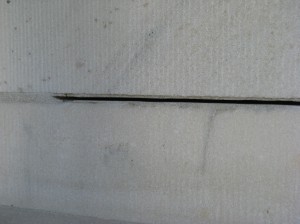By Jeffrey Larry
The rehabilitation of the Robert H. Smith Visitor Education Center (VEC) at President Lincoln’s Cottage was completed in January, 2008. Though the deterioration of mortar joints on the building was mentioned in pre-construction proposals, no extensive repairs to mortar joints were undertaken. It was believed that repairs to roofing and flashing were sufficient in addressing areas of water infiltration. After approximately 1 year of service it became apparent that water continued to enter the building causing plaster damage and peeling paint.
 An inspection in 2009 by Wagner Roofing Co. determined that the roofing and flashing repaired during the rehabilitation of the VEC was intact and was not the reason for the continued water infiltration. This left failing mortar joints as the only cause. Nearly 100 {ec117f0059f8cde3a5e4f5b3c1b486659702d407977a37ffc575d2c0a9b4a69f} of the mortar joints showed some signs of failure from cracked and loose mortar to complete loss of mortar. This was in part due to an incorrect mortar mix improperly applied at some point prior to the National Trust occupying the building in 2004.
An inspection in 2009 by Wagner Roofing Co. determined that the roofing and flashing repaired during the rehabilitation of the VEC was intact and was not the reason for the continued water infiltration. This left failing mortar joints as the only cause. Nearly 100 {ec117f0059f8cde3a5e4f5b3c1b486659702d407977a37ffc575d2c0a9b4a69f} of the mortar joints showed some signs of failure from cracked and loose mortar to complete loss of mortar. This was in part due to an incorrect mortar mix improperly applied at some point prior to the National Trust occupying the building in 2004.
After a competitive bidding process, Pointing Plus (P.P.) of Washington, DC was awarded the contract to repoint the entire building. The D.C. Commission on the Arts & Humanities (DCCAH) provided the matching funds for a grant received from the National Trust’s Historic Sites Fund.
 The project involves the removal of the incorrect mortar as well as any original mortar to a depth of approximately 1 inch. Mortar removal on historic buildings is often done by hand with chisels to avoid damage to soft brick or stone. The use of power tools such as saws or grinders is typically avoided.
The project involves the removal of the incorrect mortar as well as any original mortar to a depth of approximately 1 inch. Mortar removal on historic buildings is often done by hand with chisels to avoid damage to soft brick or stone. The use of power tools such as saws or grinders is typically avoided.
After an inspection of previous P.P. projects and a mockup on the VEC, it was decided that the use of a thin diamond-blade grinder would be allowed to remove the mortar and all removal would be closely monitored. A cut would be made down the center of the joint to relieve pressure and the remaining mortar would be removed by hand.
 The first step before removing the old mortar was to obtain a mortar analysis that would produce a new mortar that matched the original in color and texture without being harder than the original. A harder mix could potentially damage the stone. A mortar sample was sent to Virginia Lime Works (VLW) for a basic mortar analysis (acid digestion) to determine proportions of lime, aggregates and other additives. The original mix was found to contain a small percentage of portland cement. This is not entirely unusual for a building from 1905. The years 1900-1909 saw an increase of 2000{ec117f0059f8cde3a5e4f5b3c1b486659702d407977a37ffc575d2c0a9b4a69f} in the production of portland cement over the previous ten years. By the end of the 19th century “with the thought that stronger mortar was better, portland cement was increasingly added in larger and larger volumes to the lime sand mixture, in some cases eliminating the lime altogether by the turn of the century.” (John Speweik – The History of Masonry Mortar in America 1720-1995)
The first step before removing the old mortar was to obtain a mortar analysis that would produce a new mortar that matched the original in color and texture without being harder than the original. A harder mix could potentially damage the stone. A mortar sample was sent to Virginia Lime Works (VLW) for a basic mortar analysis (acid digestion) to determine proportions of lime, aggregates and other additives. The original mix was found to contain a small percentage of portland cement. This is not entirely unusual for a building from 1905. The years 1900-1909 saw an increase of 2000{ec117f0059f8cde3a5e4f5b3c1b486659702d407977a37ffc575d2c0a9b4a69f} in the production of portland cement over the previous ten years. By the end of the 19th century “with the thought that stronger mortar was better, portland cement was increasingly added in larger and larger volumes to the lime sand mixture, in some cases eliminating the lime altogether by the turn of the century.” (John Speweik – The History of Masonry Mortar in America 1720-1995)
The technicians at VLW and the head mason at P.P. agreed that it would be difficult to match the quality and proportions of the portland cement in the original mortar and that a traditional sand-lime mix would be an appropriate alternative. The traditional sand-lime mix would be slightly softer than the original mortar and provide the needed compression strength. A sample was provided by P.P using 2.5 parts sand to 1 part lime that matched the color and texture of the original mortar.
As of June 30 the VEC repointing project is approximately 70{ec117f0059f8cde3a5e4f5b3c1b486659702d407977a37ffc575d2c0a9b4a69f} completed. Though the primary intent of this project was to prevent further water infiltration, these before & after photographs from the north elevation and chimney show the aesthetic benefits to this project as well.

